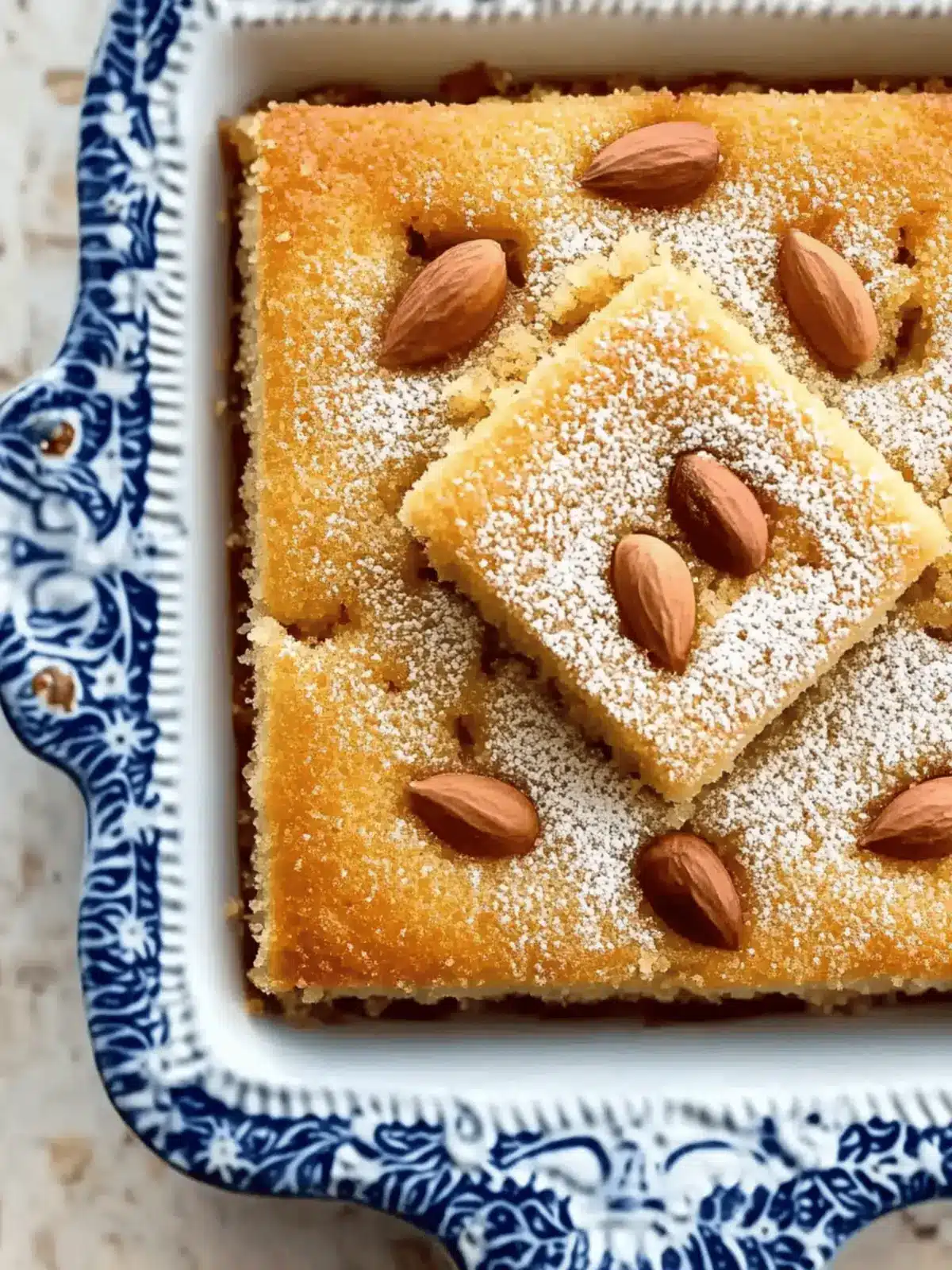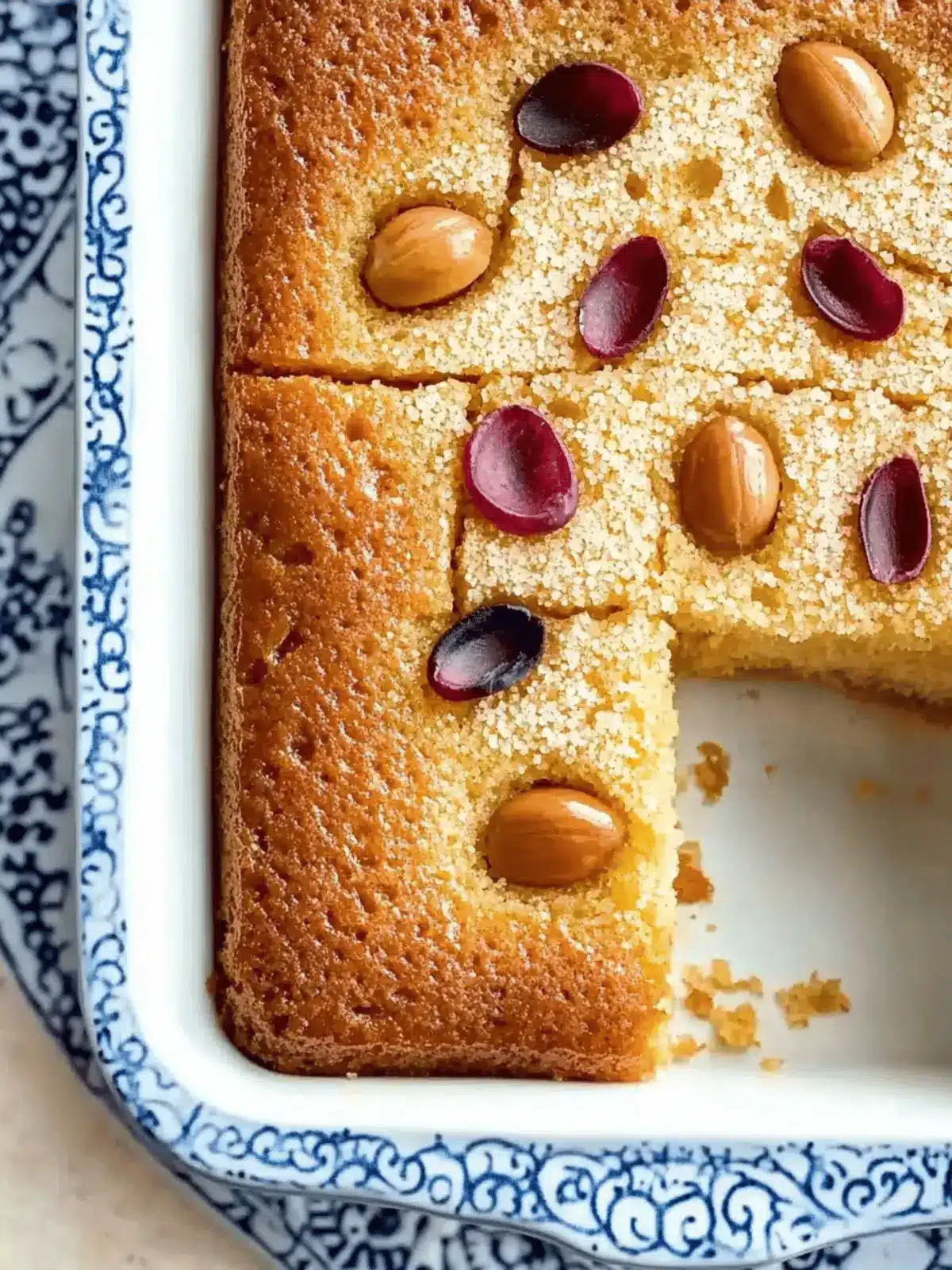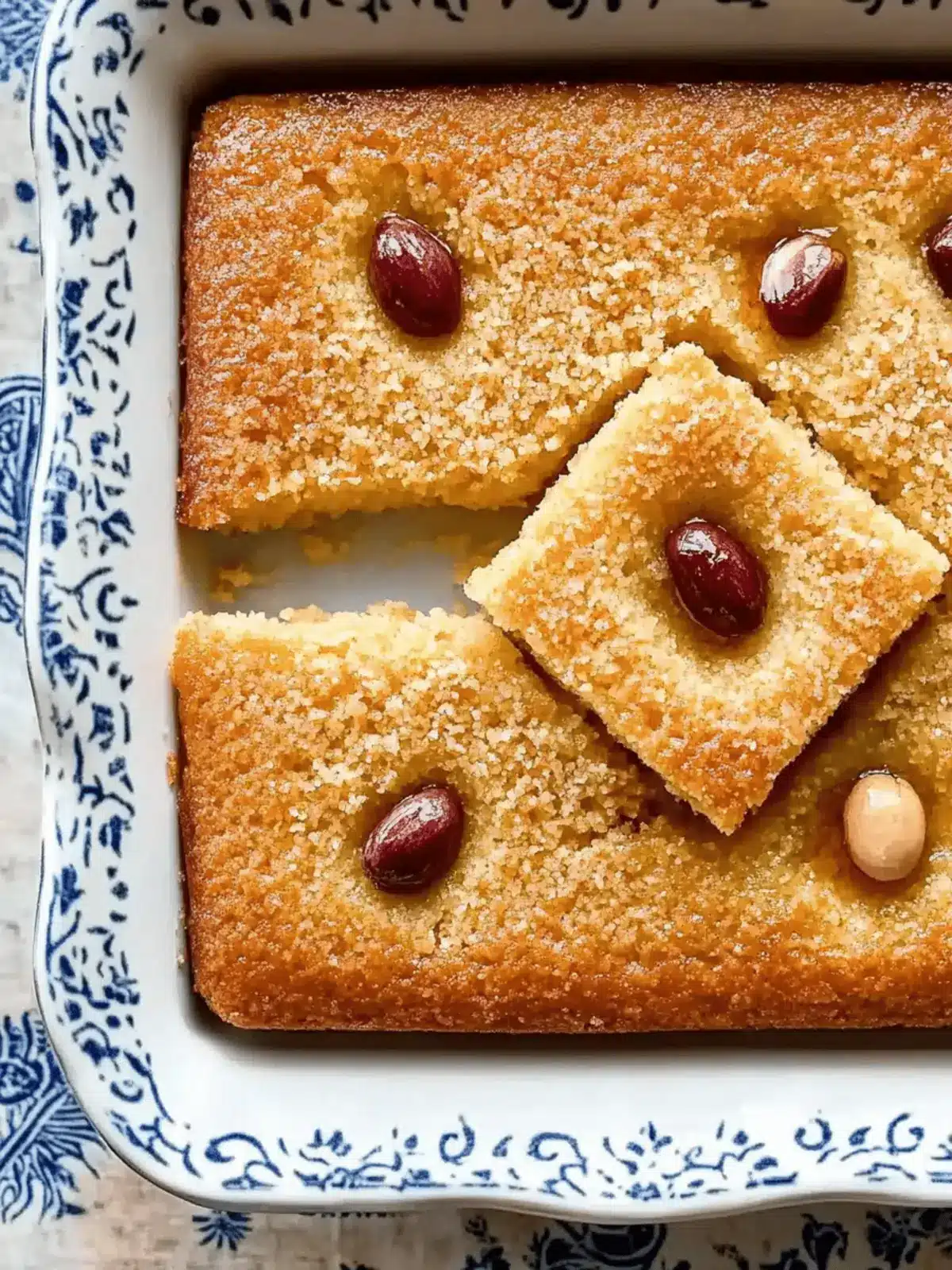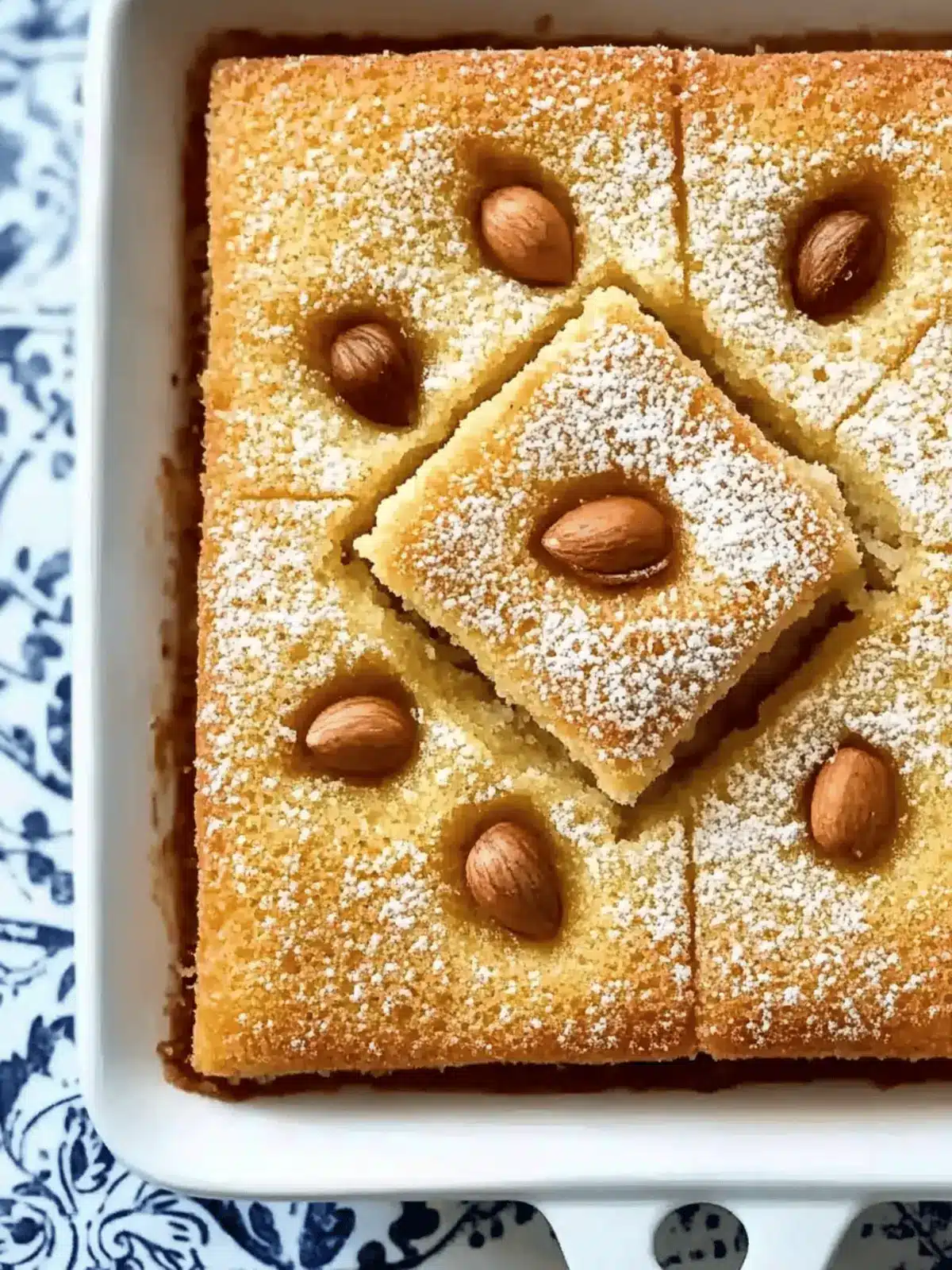As the sweet scent of baked goods wafts through the air, I find myself transported to a sun-soaked kitchen in the heart of the Middle East. It was during one of those cozy afternoons filled with laughter and warm drinks that I first encountered Basbousa, a delightful semolina cake that hugs your taste buds with its rich, moist texture and fragrant hints of coconut and almond.
Whether you’re prepping for a celebration or yearning for a comforting dessert that whispers home, this simple yet enchanting dish can brighten any day. The beauty of Basbousa lies not only in its delicious flavor but also in its effortless preparation. In less than an hour, you can treat yourself and your loved ones to a slice of this exquisite cake, topped with syrup that adds a luxurious sweetness.
Join me as we dive into this deliciously satisfying dessert that embraces simplicity and love. Perfect for gatherings or quiet evenings at home, Basbousa is the treat that will soon find a cherished place in your recipe repertoire. Let’s get baking!
Why is Basbousa the perfect dessert choice?
Irresistible, this Middle Eastern treat is unforgettable with its tender semolina texture that melts in your mouth. Simplicity reigns supreme; you’ll find the recipe straightforward and quick, taking less than an hour from start to finish. Versatile enough for any occasion, it’s the ultimate crowd-pleaser to impress guests or satisfy cravings. Aromatic hints of coconut and almond elevate its flavor profile, making each bite a delightful journey. Whether you’re a seasoned chef or a home cook, this cake will easily innovate your dessert game!
Basbousa Ingredients
• Here’s everything you need for your delightful Basbousa!
For the Cake
- 1 cup semolina – The star of this dessert, giving it that signature texture.
- 1 cup plain yogurt – Adds moisture and depth of flavor; Greek yogurt works great too!
- 1 cup granulated sugar – Sweetens the cake beautifully; adjust to taste if you prefer it less sweet.
- 1/2 cup unsalted butter, melted – Richness is enhanced with this ingredient; coconut oil can be a lovely substitution for a different flavor.
- 1 teaspoon baking powder – Ensures a light and fluffy texture for your Basbousa.
- 1/4 cup desiccated coconut – Adds a hint of tropical flavor and texture; optional if you’re not a coconut lover.
- 1 tablespoon almond extract – Infuses the cake with a beautiful nutty essence that pairs perfectly with semolina.
- Pinch of salt – Balances the sweetness, enhancing the overall flavor.
For the Syrup
- 1 cup water – The base of your syrup; ensures it has the right consistency.
- 1 cup granulated sugar – Sweetens the syrup that soaks into the Basbousa, making it irresistible!
- 1 teaspoon lemon juice – Adds a touch of acidity to prevent crystallization and enhances flavor.
- 1 teaspoon rose water or orange blossom water – A few drops of these give your syrup that enchanting Middle Eastern touch.
Now you’re all set to prepare a luscious Basbousa that will leave you and your guests craving more!
How to Make Basbousa
-
Preheat the oven to 350°F (175°C). This ensures your Basbousa bakes evenly and comes out perfectly moist.
-
Combine the semolina, yogurt, sugar, melted butter, baking powder, desiccated coconut, almond extract, and a pinch of salt in a large bowl. Mix until smooth, and let the batter sit for about 10 minutes to thicken.
-
Pour the batter into a greased baking dish (about 9×13 inches). Spread it out evenly with a spatula to ensure uniform baking.
-
Score the surface of the batter into diamond or square shapes using a knife. This will make it easier to cut after baking and gives it a beautiful presentation.
-
Top each piece with a blanched almond in the center for an elegant touch. This step is entirely optional, but it adds a lovely crunch!
-
Bake in the preheated oven for 30 to 35 minutes, or until golden brown on top. Keep an eye on it toward the end to avoid over-baking.
-
Prepare the syrup by combining the water and sugar in a saucepan over medium heat. Stir until the sugar dissolves, then add lemon juice and your choice of rose water or orange blossom water. Bring to a gentle boil for about 5 minutes, then remove from heat.
-
Pour the warm syrup evenly over hot Basbousa as soon as it comes out of the oven. This allows the cake to soak up all that sweet, syrupy goodness.
-
Cool for about 15 minutes, then cut along the scored lines. Serve warm or at room temperature, and relish every mouthful of this delightful treat!
Optional: Garnish with whipped cream or additional nuts for a touch of indulgence.
Exact quantities are listed in the recipe card below.

Expert Tips for Perfect Basbousa
• Ingredient Temperature: Use room temperature yogurt and melted butter for even mixing and a better texture in your Basbousa.
• Let It Rest: Allow the batter to sit for 10 minutes before baking—this helps the semolina absorb liquid, resulting in a moist cake.
• Scoring Technique: Score the top gently before baking to ensure even portioning; this also allows the syrup to soak in more effectively.
• Syrup Timing: Pour the warm syrup over the hot Basbousa straight from the oven; this ensures maximum absorption and wonderful sweetness.
• Taste Testing: Feel free to adjust the sweetness of the syrup; if you prefer a less sweet Basbousa, reduce the sugar in the syrup without compromising flavor.
Each tip enhances your skills in making this exquisite Middle Eastern semolina cake, creating a delightful treat for loved ones.
Make Ahead Options
These Basbousa are perfect for busy home cooks looking to save time without sacrificing quality! You can prepare the cake batter up to 24 hours in advance by mixing all the ingredients (semolina, yogurt, sugar, melted butter, baking powder, coconut, and almond extract) and storing it covered in the refrigerator. For the best results, avoid adding the syrup until just before serving to keep the cake moist and prevent sogginess. Alternatively, you can bake the Basbousa and let it cool completely, then drizzle with syrup and store in an airtight container for up to 3 days at room temperature. When ready to serve, simply cut and enjoy its delightful, syrup-soaked goodness just as fresh as when first made!
Basbousa Variations & Substitutions
Feel free to experiment and make this delectable dessert your own with these delightful variations!
- Gluten-Free: Substitute semolina with gluten-free flour to accommodate gluten sensitivities while keeping the flavors intact.
- Nutty Twist: Add chopped walnuts or pistachios in the batter for a crunchy texture and nutty flavor. Sprinkle them on top for extra appeal!
- Fruity Fusion: Incorporate mashed bananas or pureed dates into the batter for a natural sweetness and added moisture that enhances the cake’s flavor.
- Coconut Lovers: Boost the coconut flavor by using coconut cream instead of yogurt. This will give your Basbousa an incredible richness!
- Flavored Syrup: Infuse the syrup with cardamom or cinnamon for a warm, fragrant twist that transports your taste buds to the markets of the Middle East.
- Dairy-Free: Swap yogurt for a plant-based yogurt, such as almond or coconut yogurt, perfect for a dairy-free option without compromising texture.
- Chocolatey Delight: Swirl in cocoa powder or chocolate chips for a decadent chocolate version of Basbousa that’s bound to please any chocoholic.
- Chili Kick: For adventurous palates, add a pinch of cayenne pepper to the batter for a surprising hint of heat that balances out the sweetness beautifully.
These variations not only make this dish versatile but invite creativity, ensuring your Basbousa can shine in any kitchen!
What to Serve with Basbousa?
The celebration of flavors doesn’t end with just the Basbousa; pair it with delightful companions for a truly memorable experience.
-
Mint Tea: This refreshing drink creates a wonderfully aromatic contrast to the sweet richness of Basbousa. A warm cup can enhance the flavors beautifully.
-
Fresh Fruit Salad: A mix of seasonal fruits adds brightness and acidity, balancing the cake’s sweetness while refreshing your palate.
-
Whipped Cream: Light and airy, a dollop of whipped cream elevates each bite, adding a luxurious touch that’s simply irresistible.
-
Almonds and Pistachios: Sprinkle chopped nuts for added crunch; their earthy flavors perfectly accentuate the almond essence in the cake.
-
Coconut Gelato: Creamy and cool, this dessert offers a tropical twist that complements the coconut elements in your Basbousa while providing a delightful contrast.
-
Rose Water Lemonade: This vibrant drink brings a zesty kick, beautifully offsetting the sweetness of the Basbousa, making each sip a refreshing delight.
Pair these delicious items with your Basbousa, and you’ll create a feast that invites warmth and joy into every gathering!
How to Store and Freeze Basbousa
Room Temperature: Keep leftover Basbousa in an airtight container at room temperature for up to 3 days to maintain its delightful moisture.
Fridge: For longer storage, refrigerate in an airtight container for up to 1 week. Warm slices in the microwave for a few seconds for a comforting treat.
Freezer: Wrap individual pieces of Basbousa tightly in plastic wrap and then seal them in a freezer bag. It will last for up to 3 months; thaw in the fridge overnight before enjoying.
Reheating: When reheating, warm in the oven at 350°F (175°C) for about 10-15 minutes to restore its fresh-baked texture and flavor.

Basbousa Recipe FAQs
How do I choose the right semolina for Basbousa?
Absolutely! Look for fine or medium-grind semolina, which will give your Basbousa that tender texture. The quality of semolina can greatly affect the cake; brands labeled specifically for sweet baking or dessert purposes often yield the best results.
What is the best way to store Basbousa?
For room temperature storage, keep your leftover Basbousa in an airtight container—it’s best enjoyed within 3 days. If you want to extend its shelf life, refrigerate it where it can last up to 1 week. Just let it come to room temperature or warm it slightly before serving to enjoy that lovely, moist texture.
Can I freeze Basbousa for later?
Very! To freeze, wrap individual servings of Basbousa tightly in plastic wrap, ensuring there are no exposed edges. Place them in a freezer-safe bag or container, and they will keep for up to 3 months. When you’re ready to indulge, simply thaw overnight in the fridge, then reheat in an oven set to 350°F (175°C) for about 10-15 minutes.
What should I do if my Basbousa turns out too dense?
If your Basbousa is dense, it could be due to overmixing the batter or not letting it rest long enough. To prevent this, mix the ingredients just until combined and allow the batter to sit for about 10 minutes before pouring it into the baking dish. This allows the semolina to hydrate properly, leading to a lighter cake.
Are there any common allergies to consider with Basbousa?
Absolutely! The main ingredients to be cautious of include dairy (from yogurt and butter) and gluten (from semolina). If you’re cooking for guests with allergies, consider using coconut yogurt for a dairy-free option and ensure your semolina is labeled gluten-free. Always check with your guests if they’re vegetarian or have any other dietary restrictions to ensure everyone’s happy and healthy!

Irresistible Basbousa: Your New Favorite Middle Eastern Treat
Ingredients
Equipment
Method
- Preheat the oven to 350°F (175°C).
- Combine semolina, yogurt, sugar, melted butter, baking powder, desiccated coconut, almond extract, and a pinch of salt in a large bowl. Mix until smooth and let it sit for about 10 minutes.
- Pour the batter into a greased 9x13 inch baking dish and spread it out evenly.
- Score the surface into diamond or square shapes.
- Top each piece with a blanched almond in the center (optional).
- Bake for 30 to 35 minutes, or until golden brown on top.
- Prepare the syrup by combining water and sugar in a saucepan over medium heat until the sugar dissolves, then add lemon juice and rose water. Bring to a gentle boil for 5 minutes, then remove from heat.
- Pour the warm syrup evenly over hot Basbousa as soon as it comes out of the oven.
- Cool for about 15 minutes, then cut along the scored lines. Serve warm or at room temperature.






